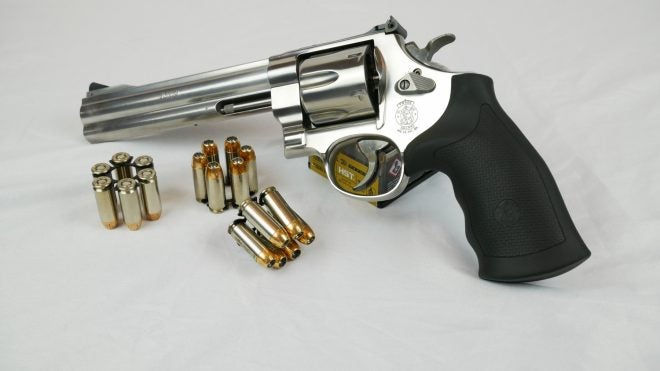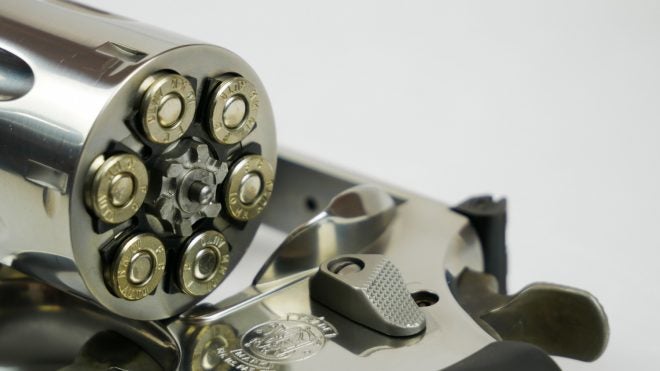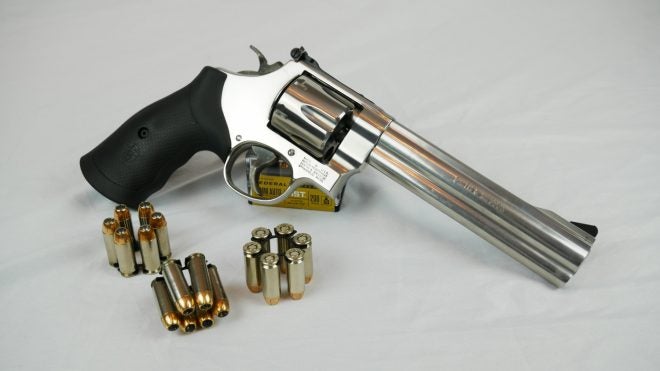The 610 is back! I’m a huge fan of The Centimeter and I also have a soft spot for Smith & Wesson revolvers. So I was excited when I found out that Smith & Wesson was bringing back the 610. The Model 610 is an N frame revolver chambered in 10mm Auto but it can also shoot .40 S&W. It’s been on again off again in production since 1990 and limited numbers were made so it’s always been a bit hard to get hold of.
The 610 is back in production now, though, and I got my sticky little fingers on the 6.5” version for testing. It will also be available with a 4” barrel.

Fit and finish on this gun are impeccable. Just the slightest hairline separates the side plate from the frame. The polished stainless finish is flawless. Not a single tool mark is visible. The bead blasted top strap matches the perfectly timed barrel and reduces glare. The hammer spur is wide and aggressively checkered, providing easy purchase. My thumb is a little short but even I could easily draw the hammer back without changing my grip.
Personally, I prefer the orange plastic insert style of the front sight, but that’s subjective and in any case, the front sight is replaceable.
Being an N frame revolver, it is heavy, at 50.1 ounces. But that weight, along with the large, comfy rubber grip, makes the recoil quite manageable, especially when firing .40 S&W. I fired 10 different 10mm loads, including a few that were pretty rowdy and I shot two .40 S&W loads and the felt recoil was honestly pretty mild across everything. Kind of a hard push like .45 Auto in a 1911 but maybe just a touch harder. Not remotely sharp or unpleasant.
The longer barrel added only modestly to the velocity in comparison to my 4.5” EAA Witness. Most loads gained about 100 fps. I’ll post the full velocity data in the description. While it is true that cylinder gap accounts for some velocity, you’ll remember that in my G29 vs G20 testing, a couple inches of barrel didn’t make a huge difference there, either.
I did have one odd malfunction. While I was firing Lehigh 140gr Extreme Defense, the cylinder started to bind. When I opened the gun up, I found that the cases were very tight to the chamber walls. That’s not uncommon for spicy loads in any caliber, but it seemed that those tight cases were holding the moon clip to the rear, keeping all the cases slightly rearward and inducing friction. I initially thought the clip might have been bent but I inspected it and it was still perfectly flat. I shot the rest of the velocity groups using that clip with no problems. If anyone knows what caused the cylinder binding, please leave a comment.
I don’t own a Ransom rest and almost any handgun is more accurate than I am, so objective reporting on group size would be worthless. I did shoot one rested 25-yard group using Federal 200gr HST, for what it’s worth. It measures about 4” but looks like it might have been tighter without errors on my part.
Like most auto pistol cartridges, 10mm is a rimless cartridge, which means that the case head is the same diameter as the rest of the case. 10mm ammunition normally headspaces on the ledge cut inside the chamber which corresponds with the case mouth. This ledge, called a shoulder, is still present in the Model 610 so you can fire 10mm without moon clips but you would have to extract each case by hand. Being rimless, you could even load the cartridges HK style.
Moon clips hold the cases in place and give the extractor star something to push against. That means that .40 can headspace so you can shoot it too if you want. Moon clips also have the added benefit of making it a lot faster to reload the revolver. When you unload a revolver, it is common for a couple cases to stick, requiring you to pluck each out individually. The solution is to fully invert the revolver and sharply strike the ejector rod with the heel of your strong hand. This technique works reliably, but it hurts my tender meat beaters after a couple iterations without gloves and some ranges frown on it because of the direction of the muzzle.

Revolvers that use moon clips eject all the spent cases at the same time and fresh ammo is fast to load. Changing out a moon clip isn’t as fast as changing out a magazine for me, mostly because I don’t have the muscle memory that an absolute Jedi like Jerry Miculek has. But it’s also slightly slower because you aren’t just lining up a big peg with a big hole. You have to line up six small pegs with six small holes. With practice, this can be pretty quick, but as slow as I am, I was still able to casually reload the 610 faster than the best I can do with a speed loader on another revolver.
Reloading the moon clips themselves can be frustrating without the use of a tool like one from Brownells. Loading fresh cartridges into an empty clip is easy enough using a flat surface, but removing spent cases without bending the clips can be rough on your fingers.
Shooting the gun was an absolute pleasure. Recoil was mild in comparison to the same loads in my EAA Witness. Smith & Wesson revolvers have fantastically smooth double action triggers right out of the box and this revolver was no exception. The wide, smooth face of the trigger works perfectly with the smooth stroke. The single action pull was as excellent as you would expect, with zero creep or grit and just the barest overtravel. Between the long sight radius, crisp target sights, and exceptional trigger, shooting steel was easy and natural.
The question hanging in the air, though, is “why?”. Why would I want a revolver chambered in 10mm instead of another caliber and why would I want 10mm in a revolver instead of an automatic? Firstly, it’s important to remember that guns are fun and it’s okay to buy a gun just because it’s beautiful and fun. I like you just the way you are. But both the 10mm cartridge and revolvers, in general, have some cool things going for them.
To be sure, there are more powerful cartridges. .41 and .44 Magnum are both more powerful than 10mm. But they also recoil more. If the only thing that ever mattered was the power we would all be carrying .500 S&W or 60mm HE.

Why not .357 Magnum, though? It’s true that 10mm and .357 Mag have similar velocity for a given bullet weight. But 10mm can launch heavier, wider projectiles and .357 Mag has higher sectional density. So with the same bullet weight and style, the .357 Mag will usually go deeper and the 10mm will cut a wider wound channel. And remember those moon clips? Reloading the 610 is faster and more convenient than reloading a .357 revolver, even with a speed loader. Both are great cartridges, and either would be suitable in any role that the other does well at. It largely comes down to personal taste.
But why would someone want a revolver in 10mm instead of an automatic? One big reason is the ability to load a round of snake shot when hiking and still be able to fire the remaining rounds quickly. If you shoot snake shot in an auto, you’ll have to manually cycle the slide to fire another round. Another point in favor of revolvers is they tend to be more accurate. Not that autos can’t also be accurate of course, but the sights and trigger on a factory revolver make accurate shooting from field positions easier for me than with most autos. It’s also worth noting that a frame designed for .44 Magnum ought to be more durable in the long term with max pressure loads. If you want to shoot a lot of full “nookular” hand loads, this 610 will probably last longer than a G20 before something needs to be replaced.
Finally, you can shoot .40 S&W from it. Technically you can shoot .40 from a 10mm pistol but it is not recommended by any manufacturer so far as I know. Smith & Wesson expressly states that .40 can be fired in the 610.
Ultimately, the Model 610 doesn’t do anything profoundly better than other guns in .357 Mag or 10mm but it also doesn’t do anything worse. The 610 would be slightly better or slightly worse at any given job than most other guns chambered in 10mm or .357 magnum. It comes down to what your preferences are. If you like 10mm and you like revolvers, get one. You will not be disappointed. This is exactly what a revolver ought to be. And if you need some ammo for it, take a look at what Ventura has in stock. Their support makes these videos possible and they provided the ammo I used in testing. The best way to support this channel is to support our sponsors.
I’m also grateful to Smith & Wesson for letting me borrow this gun. I’m not looking forward to sending it back. And I want to thank AR500Armor.com for providing the targets. But most of all, I want to thank all of you for supporting this channel.
I hope you enjoyed this video, but if you think a 10mm revolver is a stupid idea and want to tell me all about it, go ahead and leave a comment. I’d love to hear it, even if you’re wrong. Have a great day!
Five shot averages in fps:
S&W Model 610 6.5″ barrel 200gr HST: 1,145
EAA Witness 4.5″ barrel 200gr HST: 1,055
S&W Model 610 6.5″ barrel S&B 180gr JHP: 1,141
EAA Witness 4.5″ barrel S&B 180gr JHP: 1,056
S&W Model 610 6.5″ barrel S&B 180gr FMJ: 1,162
S&W Model 610 6.5″ barrel Underwood 165gr Gold Dot: 1,397
S&W Model 610 6.5″ barrel Hornady 175gr Critical Duty: 1,175
EAA Witness 4.5″ barrel Hornady 175gr Critical Duty: 1,083
S&W Model 610 6.5″ barrel Super Vel 160gr SCHP: 1,292
EAA Witness 4.5″ barrel Super Vel 160gr SCHP: 1,211
S&W Model 610 6.5″ barrel Lehigh 140gr ED: 1,639
EAA Witness 4.5″ barrel Lehigh 140gr ED: 1,484
S&W Model 610 6.5″ barrel Speer 200gr Gold Dot: 1,081
EAA Witness 4.5″ barrel 200gr Gold Dot: 1,002
S&W Model 610 6.5″ barrel Ventura 180gr JHP: 1,408
EAA Witness 4.5″ barrel Ventura 180gr JHP: 1,313
S&W Model 610 6.5″ barrel Federal 180gr Trophy Bonded JSP: 1,337
EAA Witness 4.5″ barrel Federal 180gr Trophy Bonded JSP: 1,213
TNW Aero Survival Pistol 10.5″ barrel Federal 180gr Trophy Bonded JSP: 1,421
S&W Model 610 6.5″ barrel Blazer Brass 180gr FMJ: 997
S&W M&P 4.25″ barrel: 951
S&W Model 610 6.5″ barrel Federal 155gr Hi-Shok: 1,174
Glock 22 4.5″ bbl Federal 155gr Hi-Shok: 1,128
 Your Privacy Choices
Your Privacy Choices